New York Catocala
Catocala obscura, Ithaca, Tompkins County, New York,
August 8, 2012, courtesy of Meena Haribal.
|
|
Updated as per "Systematics of moths in the genus Catocala (Lepidoptera, Erebidae) IV. Nomenclatorial stabilization of the Nearctic fauna, with a revised synonymic check list"; ZooKeys 39: 37–83 (2010) by Lawrence F. Gall, David C. Hawks; March 21, 2010 |
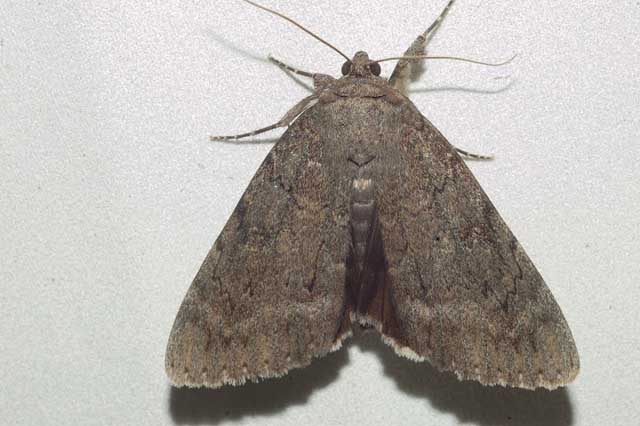
Catocala obscura, Ithaca, Tompkins County, New York,
August 8, 2012, courtesy of Meena Haribal.
I also wish to acknowledge, with thanks, the data and/or images sent to me or made available by Marie Winn (Central Park, Manhattan, New York County), Hugh McGuinness (Suffolk County), Randy Lyttle (Otswego County, Wayne County), Meena Haribal, and other individuals sited for sighting data and/or images.
Please help improve the accuracy and comprehensive coverage by sending data/images to Bill Oehlke. All images ued are credited and remain the property of the respective photographers.
As of April 4, 2010, this page has been further updated as per research data compiled by Larry Gall.
I would like to continue to refine the listings to county levels so images and data (date, location at least to county level,
bait, lights) would be very much appreciated. Please send same to Bill Oehlke.
All images that I use on my websites remain the property of respective photographers and images are credited as such.
The Identification Keys Diagram should help you understand the terminology I have used in describing the various species.
Visit Sphingidae of New York: Hawkmoths, Sphinx Moths.
Little Yellow-Orange Underwings: Wingspans: 35-45mm
Little Yellow-Orange Underwings: Wingspans: 35-56mm |
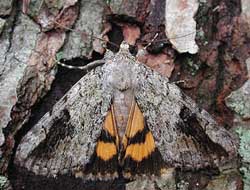
| ** 8876 Catocala micronympha, the Little Nymph Underwing, (wingspan: 35-50mm). John Himmelman image. Usual specimens have grey forewings shaded with green, brown, black and white tints. Usually a darkened band passing from costa through reniform spot to outer margin. High variability. Full size Joe Garris photo of C. micronympha form hero. |
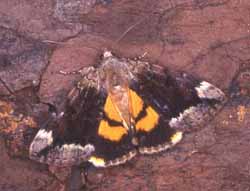
| ** 8876 Catocala micronympha
form gisela,
the Little Nymph Underwing, (wingspan: 35-50mm). |
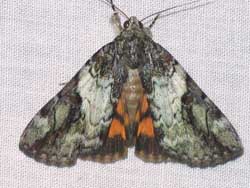
| ** 8876 Catocala micronympha
form hero,
the Little Nymph Underwing, (wingspan: 35-50mm).
The usual specimens have grey forewings shaded with green, brown,
black and white tints. There is usually a darkened band passing from
the costa through the reniform spot to the outer margin.
Form "hero" H. Edwards has a median area that is mostly white. |
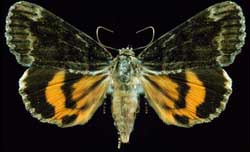
| ** 8876 Catocala micronympha form lolita, the Little Nymph Underwing, (wingspan: 35-50mm).Form "lolita" Sargent has very dark forewings. Harold J. Vermes image, used with permission from his son. |
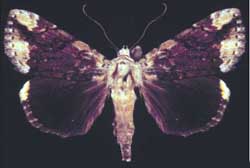
| ** 8876 Catocala micronympha form sargenti, the Little Nymph Underwing, (wingspan: 35-50mm). Usual specimens have grey forewings shaded with green, brown, black and white tints. Usually a darkened band passing from costa through reniform spot to outer margin. Form "sargenti" Covell (very rare) has a hindwing that is all black. |
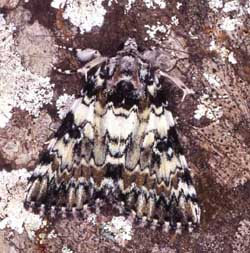
| ** 8877 TONHS connubialis, Connubial Underwing; 35-50mm). Fw highly variable; several different forms: "sancta" Hulst: typical form, forewings with white ground colour & sharply contrasting black lines & markings. Brown shading between post medial and subterminal lines; "cordelia" H. Edwards:s coloured as above, markings are faint; "pulverulenta" Brower: grey-green forewings with faint markings, sometimes none; "broweri" Muller: melanic form with fws dark green, almost black. Hw has separate anal spot and outer band ends with a straight cut. |
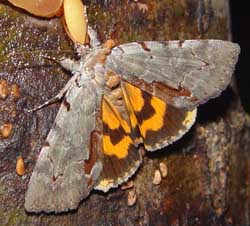
| ** 8864 TONHS Catocala grynea ; Woody Underwing; 40-50mm |
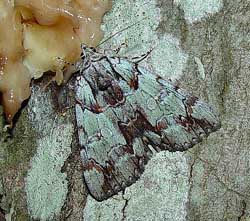
| ** 8865 TONHS praeclara; Praeclara Underwing; 40-50mm.
Fw pale greenish-grey with considerable contrasting
brown shading beyond post medial line.
There is a black basal dash very close to the inner margin and
another dash, higher up in the median area.
Note the contrasting shapes of the reniform and subreniform spots. |
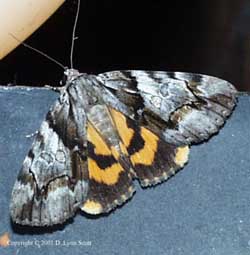
| ** 8867 Catocala blandula;
Charming Underwing, wingspan: 40-50mm. |
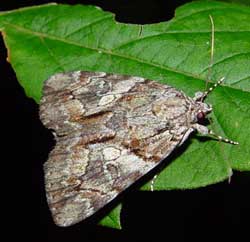
| Catocala mira; Wonderful Underwing, wingspan: 40-50mm. Pale basal area of fw distinguishes mira from blandula (dark brown) and crataegi (black). Fw lacks dark contrasting lines of crataegi and blandula. Considerable brown in subterminal area and subreniform spot very conspicuous, usually brown. Light area runs obliquely from costa to subreniform spot. Noticeable space along i. m. between antemedial and postmedial lines. Hw deep orange and has a complete inner black band. The outer black band is unbroken Tim Dyson image. |
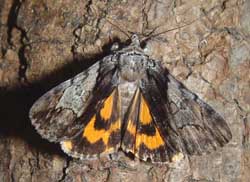
| ** 8858 TONHS Catocala crataegi WO; Hawthorn Underwing; 40-50mm. Determination is based on dark (black) shading in forewing basal area continuing along inner margin to anal angle and brown shading beyond postmedial line. There is also a definite greenish cast to median area. The lower wing has the outer black band, broken near the anal angle, distinguishing crataegi from blandula. Tim Dyson image. |
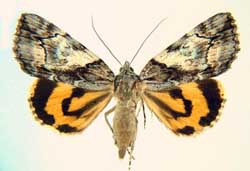
| TONHS Catocala pretiosa Precious Underwing; 40-50mm; This species is quite similar to crataegi and mira, but pretiosa has considerable creamy white colouration in the median area. The lower portion of the basal area is also light, not dark as in crataegi. The inner black band of the hindwing forms a loop and the outer band is broken (not complete as in mira, followed by a dot that tapers to the anal angle. |
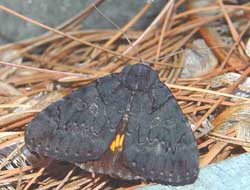
| ** 8775 TONHS antinympha; Sweetfern Underwing; 45-55mm. The very dark grey, almost black, forewing ground colour distinguishes antinympha. There is some brown shading in the subreniform spot and also just outside the postmedial line. The hindwing is amber to pale orange. There is also the form multoconspicua Reiff, 1919 with a pale, almost white subreniform spot. Tim Dyson image. |
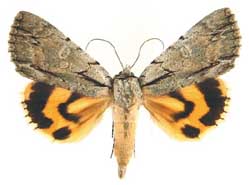
| ** 8772 TONHS clintoni; Clinton's Underwing, wingspan 45-55mm.The black basal dash distinguishes clintoni from illecta and abbreviatella, both of which lack the dash. Vernon Brou image. |
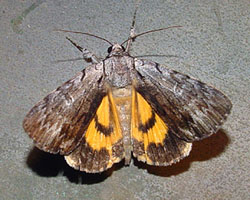
| ** 8772 TONHS gracilis; Graceful Underwing, wingspan 40-45mm.Gracilis closely resembles sordida but the hindwing loop is not complete in gracilis as it is in sordida. Gracilis also tends to have a darker inner margin and there is frequently (99% of the time, Dale Schweitzer, via Joe Garris), but not always, a basal dash. Sordida never has the basal dash. |
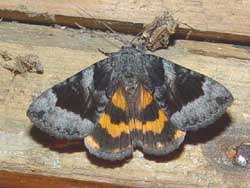
| ** 8776 TONHS badia coelebs;
Old Maid Underwing 54-56mm. |
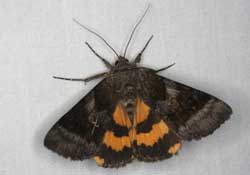
| ** 8777 Catocala badia; Bay Underwing, 50-60mm. Fw buff-brown, deeper brown in basal area and within pm line; paler beyond pm line; lines faint, barely traceable. HW yellow-orange with black bands; often with terminal yellow-orange line at base of fringe. NH. specimens may appear transitional to coelebs, having the sharp bend of upper part of pm area and more distinct lines of that species." |
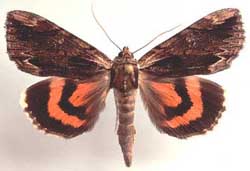
| ** 8857 Catocala ultronia; Ultronia Underwing, wingspan: 50-63mm.Fws typically gray-brown, with a distinct and very dark inner margin and characteristic light brown patch, underscored by very dark arc, near wingtip. Underwings can be yellow to orange to salmon. |
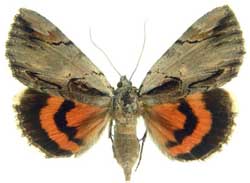
| ** 8857 Catocala ultronia form lucinda; Ultronia Underwing, wingspan: 50-63mm.In form lucinda most of the forewing is bright grey. On all forms there is
extensive orange-salmon colouration on hw ventral surface,
and there is a dark discal lunule. |
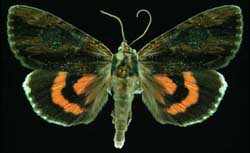
| Catocala ultronia, form nigrescens, the Ultronia Underwing, wingspan: 50-63mm. In the melanic form nigrescens, the dorsal forewing is very dark. Even darker subapical arc, basal dash and dash near anal angle are still visible. Dark basal hairs on hindwing. Harold J. Vermes slide, used with permission from his son. |
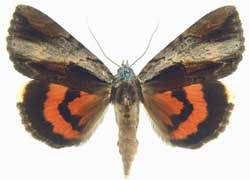
| Catocala ultronia form celia.
In form celia there is a wide, light grey band separating a dark region along inner margin and
a dark patch near the apex.
The ventral surface of forewings of all forms has a generous suffusion
of orange-salmon scales in the lower half of the median area. |
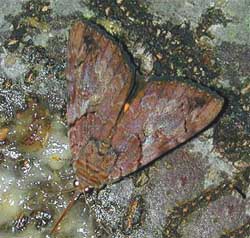
| ** 8774 muliercula; Little Wife Underwing, 54-70mm. The black bands of the hindwings tend to be very wide and there is considerable dark scaling along the inner margins. Hw fringe is very dark as is the general reddish-brown ground colour of the forewings.The forewing apex is preceded along the costa by a lighter, grey-brown patch. Steve Walter image. |
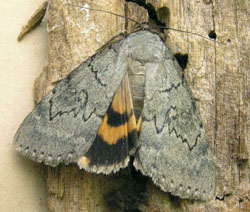 |
** 8779 TONHS serena Serene Underwing. Head, collar & abdomen: brown, thorax: gray. Am & pm lines thin but very dark & distinct on drab, almost uniformly olive-grey fw. Hw black marginal band indented at center, relatively narrow, deep yellow median band parallels this indentation. Basal hairs: brown. |
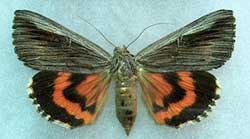
| TONHS Catocala herodias gerhardi; 55-65mm. Fw grey & brown, generally lacking any trace of medial lines. Veins somewhat darkened in median areas with white streaks from pm line to outer fringe, running parallel to im. Distinctive very light, almost white, border along forewing costa. |
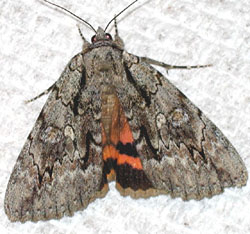
| #8778 TONHS Catocala habilis; 55-65mm. Note large "M" on thorax & "pork chop" shaped, light coloured subreniform spot becoming very dark in constriction at juncture with pm line. Pm line narrow, dark & distinct, outwardly lined with narrow suffusion of white scales, then broader band of brown scales, then broader suffusion of white scales up to regular dentation of st line. Always significant "bleeding" of yellow-orange to salmon scales into hw fringes. Large reniform spot has brown center, faintly edged with black, then white, then black again. |
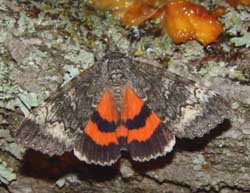
| #8817 TONHS briseis; Briseis Underwing; 60-70mm. Fws predominantly mottled dark-grey-brown with some lighter areas 1) between pm & st lines, 2) at base of am & pm lines along im, & 3) over subreniform spot running diagonally toward costa. Pm lines without greatly elongated & sharly pointed "teeth" near apex. Hw fringe white & unbroken & inner black band (fairly even) reaches inner margin. Tim Dyson image. |
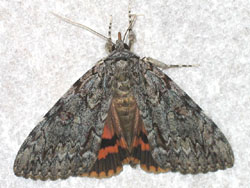
| #8795 TONHS Catocala palaeogama ; 60-70mm. Subreniform spot closed, does not approach pm line, smaller than in C. habilis. All forms have characteristic orange, heavily barred fringe to apex, & irregular bands on hws. Hw basal median area heavily suffused with dark brown to black scales. Dark bar in outer half of median area, paralleling inner margin halfway between inner margin & light, closed subreniform spot. |
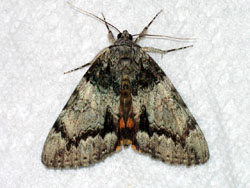
| #8795 TONHS Catocala palaeogama
form phalanga; 60-70mm.
In this form, the forewing basal area and subterminal
area are very dark against a much lighter background.
|
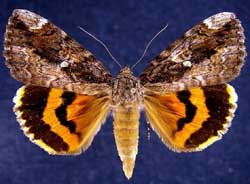
| ** 8770 Catocala innubens; Betrothed; 55-72mm. TONHS Forewing is mottled with white, grey and brown, and subrenifrom spot tends to be lighter in colour, although it is sometimes obscured by an indistinct blackish bar which runs from middle of basal/thorax connection to just below much lighter apex at outer margin.Jim Vargo image. |
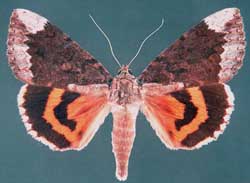
| ** 8770 Catocala innubens form scintillans; Betrothed; 55-72mm.In form scintillans most of the basal area (all but lower third) and all of the median area of the forewing is dark reddish brown. The area outside the pm line is grey. Vernon A Brou image. |
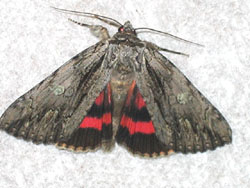
| ** 8851 TONHS Catocala coccinata; Scarlet; 57-70mm. Usually diffuse basal & anal dashes on otherwise light grey, mottled forewing. Hw fringe white (often with some salmon scaling); heavily checked. "Tooth" just below pair of elongated "teeth" much reduced, quite rounded, usually allowing considerable room for lighter patch of scales. Dark bar crosses thorax. Reniform spot tends be to light, often with greenish cast. |
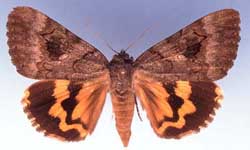
| ** 8772 Catocala consors WO; Consort, wingspan: 70mm plus. Fw with irregular am and pm narrow black lines. Dark patch outside the reniform and subreniform spots. The orange-yellow hindwing pm band tends to be narrow and irregularly zigzagged. Sometimes the band is wider and slightly less irregular. James K. Adams image. |
Catocala robinsonii Grote 1872 (Catocala) TONHS
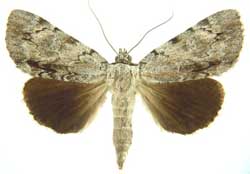
| miranda, Miranda Underwing; 37-45mm; Fw: plain pale grey with very light and fine black lines, darker and wider near costa. Hw black with white fringe at the apex, turning to grey along the outer margin. Miranda is smaller than look-alike orba and miranda also has a dark bar just above the inner margin in the median area, projecting toward the anal angle. Qestionable ?? |
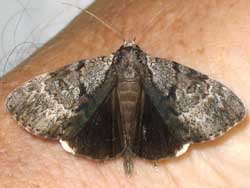
| ** 8849 TONHS Catocala andromedae, Gloomy Underwing; 40-50mm. Black hws & dark grey hw fringe, dark inner margin of fws help to identify this species. Very dark "flying saucer" shape, adjoining subreniform spot to midpoint of antemedial line. The "teeth" of postmedian line are short and blunt, outwardly edged with white. Subterminal line is also outwardly edged with white. |
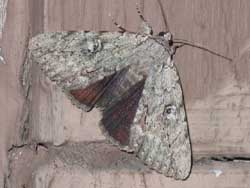
| ** 8781 TONHS judith, Judith's Underwing; 45-55mm. One of smaller "black" underwings. Fw uniform light grey with thin and only slightly darkened antemedial, median and postmedial lines. No darkened dashes (slight anal dash) or transverse lines. Reniform area slightly darkened while area just before subterminal line is a bit lighter. Note absence of hw white fringe. Joe Garris photo. |
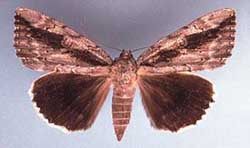
| ** 8782 TONHS Catocala flebilis ; Mournful Underwing, wingspan: 54-65mm. Diffuse black band runs from basal area to outer margin just below apex, interrupted by pale grey subreniform spot. Reniform spot is filled with brown, additional brown outside the postmedial line. No anal dash as there is in angusi. |
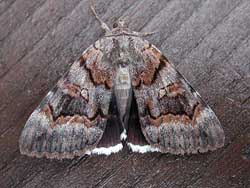
| ** 8773 TONHS
Catocala epione ;
Epione Underwing, wingspan: 55-65mm |
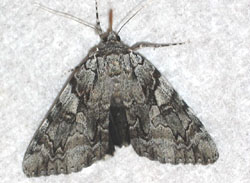
| ** 8790 TONHS Catocala dejecta, 56-73mm. Quite similar to Catocala retecta. Light coloured subreniform spot is also open, but has distinct "pork-chop" shape & separates much darker median area below subreniform spot from very light area to costa above spot. Lower quarter of submarginal area is also much darker in C. dejecta than in C. retecta. |
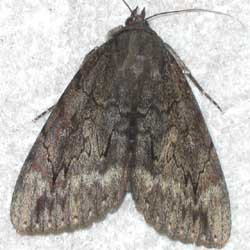
| Catocala residua; Residua Underwing, 60-73mm: distinguished from Catocala obscura by grey hw fringe of residua. Catocala obscura has white to off-white fringe and tends to be less common in northern portions of its range. Fw subterminal line/area of Catocala residua tends to be pale as is its open, elongated sbrnfrm spot. Like C. obscura it is otherwise devoid of significant markings except for hint of dark bar running from basal area through rnfrm spot to o. m. just below apex. |
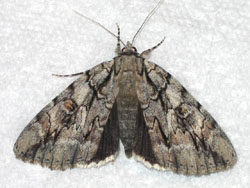
| TONHS Catocala retecta; 60-75mm. Light coloured, elongated, open sbrnfrm spot interrupting dark, diffuse ark running through center of wing from basal area (body-wing juncture) to fw apex. Center of rnfrm spot: brown; brown area just below costa running to i m just outside pm line. Off-white hindwing fringe: only lightly checked along veins. |
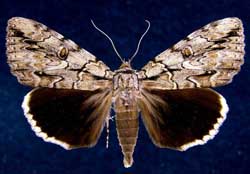
| Catocala luctuosa, Underwing, (wingspan: 70mm). Fw light grey (yellowish tint) clearly marked with a basal dash that continues with another dash through the am line, followed by another anal dash almost forming bar parallel to im. Hw fringe white, lightly barred at veins. Fw pml "teeth" elongated and dark, continuing dark dar emanating from om just below apex. |
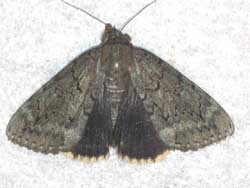
| ** 8784 TONHS obscura; the Obscure Underwing; 60-72mm. Dull, grey fws, usually void of any significant dashes or streaks, providing for easy identification. Antemedial, median & postmedial lines of obscura are faint and subterminal line region is only slightly paler than rest of fw. The hindwing fringe is off-white and lightly checked on the veins. Joe Garris photo. |
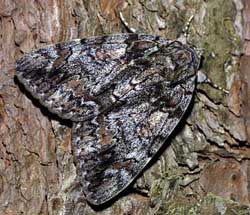
| ** 8794
Catocala lacrymosa;
Tearful Underwing, 60-82mm.
The forewing is highly variable with a mixture of black, brown
(wing tips and outside postmedial line) and dark grey scaling.
There are usually whitish crescents, along the inner margin at the
base of the antemedial and postmedial lines. |
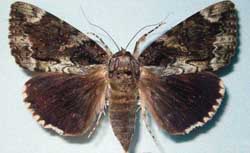
| ** 8794
Catocala lacrymosa;
Tearful Underwing, 60-82mm.
Form paulina: lighter grey post median area & area along and parallel to inner margin, in sharp contrast to
darker basal median areas. |
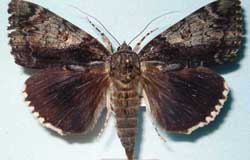
| ** 8794
Catocala lacrymosa;
Tearful Underwing, 60-82mm. |
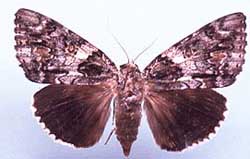
| ** 8794
Catocala lacrymosa;
Tearful Underwing, 60-82mm. |
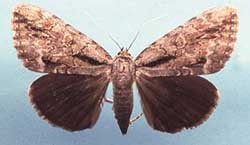
| ** 8783 TONHSCatocala angusi WO; Angus' Underwing, 60-74mm; Dark dashes/streaks in basal & anal areas distinguish angusi. Reniform spot has light brown filling. Hw fringe black except for apical white region. "lucetta": broad black band from basal area to om, broken by reniform & subreniform spots. |
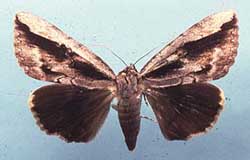
| ** 8783 Catocala angusi TONHS; Angus' Underwing, 60-74mm; Dark dashes/streaks in basal & anal areas. Reniform spot: light brown filling. Hw fringe black except for white region at apex. Form lucetta has broad black band from basal area to om, broken only by reniform & subreniform spots. James K. Adams image. |
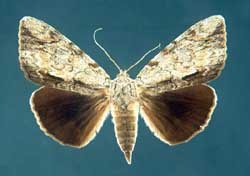
| ** 8791 TONHS
Catocala insolabilis;
Inconsolable; 65-75mm.
Fw light grey with blackish shading along inner
margin. Antemedial &postmedial lines are thin.
Hw fringe very narrow and grey, becoming whiter toward
apex.
Ventral surface clearly distinguishes insolabis, being almost
completely black except for some white in the basal area. |
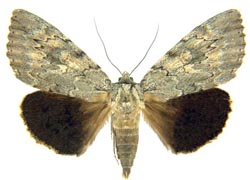
| ** 8780 Catocala robinsoni; 70-80mm. Fws relatively plain pale grey. Female has basal dash, absent in male. Currata French, 1882, female form: weak basal dash. Rare form missouriensis Schwarz, 1915: dark, broad bar extending from basal area to o.m. just below apex. Lighter grey rnfm, subrnfm spots break bar in missouriensis, found from PA. to FL. Hw fringe: White; bands on ventral surface prominent. |
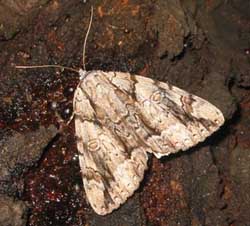
| ** 8792 TONHS Catocala vidua; Widow; 70-80mm. Fw ground colour light grey. Distinguished dark arc running through top of reniform spot to just below apex. Heavy, dark anal and basal dashes, connecting toa dark median bar, running parallel to inner margin. The am line is thick and black in its upper half. The reniform spot consists of two almost concentric irregular ovals. Subreniform spot is light, open, but constricted as it meets pm line. Hw black with broad, white fringe, only lightly interrupted. Marie Winn image. |
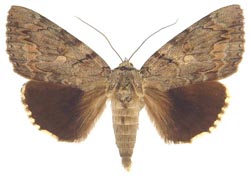
| Catocala agrippina 75-85mm; In males, fws are grey-black with some reddish brown (distinguishing characteristic); am and pm lines are black, darker toward costa, much lighter near inner margin. Reniform indistinct and brown; sub-reniform almost obsolete, but lighter than surrounding areas. Hws black, with greyish hairs at base and im. Fringe white, only partly cut with black at vein terminations. |
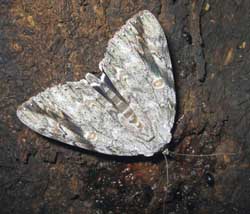
| ** 8793 Catocala maestosa, Sad Underwing, wingspan: 78-98mm. Maesotsa is quite similar to, although usually larger than, vidua. Both have the dark arc from the costa, above the reniform spot, to the outer margin just below the apex. Maesotsa, however, lacks the dark bar, found on vidua, parallel to the inner margin. The reniform spot is brown and there is brown shading just outside the postmedial line. The hindwing fringe is white, narrow and heavily barred. |
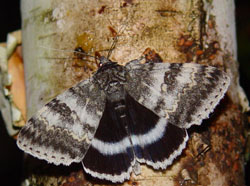
| ** 8803 TONHS Catocala relicta
;
Forsaken, White, Relict; 70-80mm:
Considerable variation with regard to black/white
concentrations on fws. |
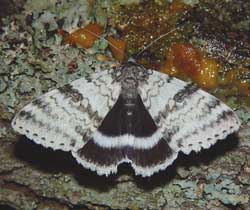
| ** 8803 Catocala relicta ; Forsaken, White, Relict; 70-80mm: Considerable variation with regard to black/white concentrations on fws. Form clara: basal and subterminal areas predominantly white.Typical specimens have basal and subterminal areas with blackish scales. Black hws, with brilliant even white inner band and white fringe, are distinctive. June until October. |
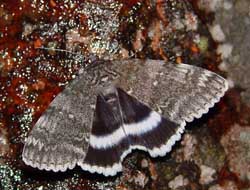
| ** 8803 Catocala relicta ; Forsaken, White, Relict; 70-80mm: Considerable variation with regard to black/white concentrations on fws. Form phrynia: evenly dusted with grey over entire forewing. Typical specimens have basal and subterminal areas with blackish scales. Black hws, with brilliant even white inner band and white fringe, are distinctive. June until October, poplars and willows |
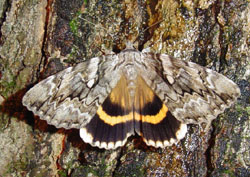
| ** 8802 TONHS Catocala cerogama; Yellow-Banded; 70-80mm. Several different forms. Pm line distinct, dark and has elongate pair of projections. Pm and am lines meet inner margin in relative proximity. Closed subreniform spot lighter than surrounding areas, shaped a bit like an arrowhead with point toward body. Hws are distinctive. Jean-Benoît Duval image. |
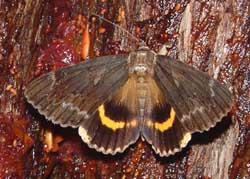
| ** 8802 Catocala cerogama; Yellow-Banded; 70-80mm.Form ruperti: Forewings are almost uniform grey-brown with white scales outlining subterminal line. The hindwings are distinctive. Tim Dyson image. |
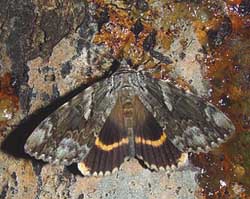
| ** 8802 Catocala cerogama; Yellow-Banded; 70-80mm.Form bunkeri: Forewings are dark in median and basal areas. Hw golden band is reduced in thickness. Basal hairs are brown instead of yellow. The hindwings are distinctive. Tim Dyson image. |
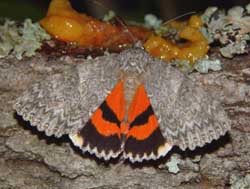
| ** 8822 TONHS meskei; Meske's Underwing; 65-75mm. Fws less distinctly marked compared to unijuga, some red-orange at hindwing apex and just inside fringe along outer margin in meskei that is lacking in unijuga. Fw subreniform spot opened or connected to postmedian line. Hw postmedian band is nearly straight, turned in and tapering near anal angle. Tim Dyson image. |
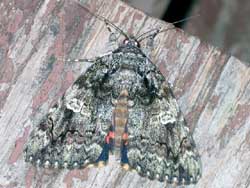
| ** 8801 TONHS Catocala ilia; Ilia; wingspan: 65-82mm. Several different forms, most have characteristic white area in and around reniform spot. Diffuse dark arc running from this spot to just below apex. Subreniform spot squarish, concave inner and outer edges and elongated constriction connecting it to pml. White dots near fw om in character with the overall "contrasting" appearance. |
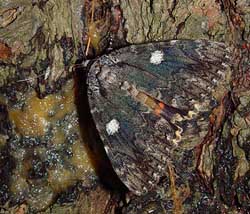
| ** 8801 Catocala ilia; Ilia; form conspicuaIn this form the entire reniform spot is heavily suffused with white scaling on an otherwise darker ground colour. Hence the form name "conspicua". Tim Dyson image. |
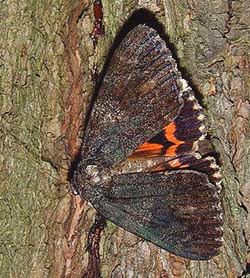
| ** 8801 Catocala ilia; Ilia; form satanasIn this melanic form the entire forewing, including the reniform spot is very dark. Hence the form name "satanas". The dark basal streak is still evident on this form. Tim Dyson image. |
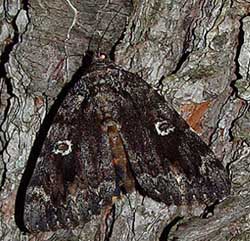
| ** 8801 Catocala ilia; Ilia; form normaniIn this semi-melanic form the entire forewing, excluding the reniform spot, is relatively dark. The brownish, kidney-shaped center of the reniform spot is outlined in white. The basal streak and subapical arc are still visible. Tim Dyson image. |
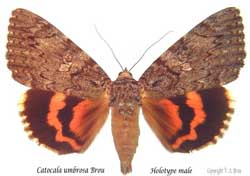
| ** 8857.1 Catocala umbrosa; mm; Double brown am line, inward line fainter, filled with off white; reniform spot brown center outlined in black , off white and black again; subreniform, large, pale brown, closed. Pm line wit htwo elongated upper teeth, next tooth reduced, next two progressively longer, rounded, final lobe rounded and shorter. HW with dark scaling/hairs in basal median area along im |

| ** 8772 Catocala consors WO; Consort; 70mm plus. Fw has irregular am & pm narrow black lines. Dark patch outside reniform & subreniform spots. The orange-yellow hindwing pm band tends to be narrow and irregularly zigzagged. Sometimes the band is wider and slightly less irregular. James K. Adams image. |
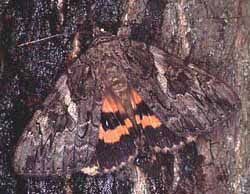
| ** 8771 TONHS Catocala piatrix ; Penitent, wingspan: 68-84mmThe forewing has a light-colored band/bar extending from the subreniform spot along the am line to the costa. The fringe of the hindwing is lightly barred and is lighter in color than the deeper orange on the rest of wing. |
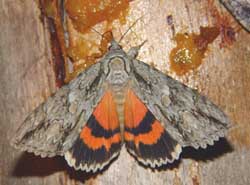
| ** 8806 TONHS Catocala parta; Mother Underwing; 70-85mm. The black dashes in the basal, subapical and anal areas help to identify this species. The hindwings may be yellow to yellowish-orange but more often are salmon-red. Note the face-head-like markings on the thorax. In the hindwing, the first (nearest the apex) black protrusion into the white fringe is "noticeably" larger than the others. |
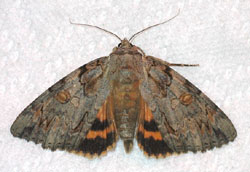
| ** 8798 TONHS Catocala neogama; 70-85mm. Note brown head, thorax & larger size as compared to palaeogama. Neogama slightly smaller than subnata, have darker grey brown fws with more pronounced markings. Hind tibia examination sometimes needed for id. Neogama': flattened & unevenly & sparsely spined; subnata: cylindrical with spines dense & uniform in distribution. Joe Garris photo. |
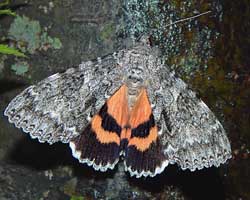
| ** 8805 unijuga; Once-married; wingspan: 70-90mm: Catocala unijuga has a fairly wide black inner band (almost reaching inner margin) in hindwing and very distinctive patterning in forewing. Meskei tend to have narrower band and dustier (less distinct) looking forewing. Semirelicta tend to have inner bands that terminate well before inner margins. Also note the very white fringe on both the forewings and hindwings. Carroll Rudy image. |
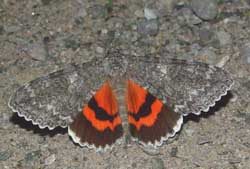
| ** 8805 unijuga; Once-married; 70-90mm.Form agatha has a much darker, evenly grey forewing. Hindwings have some darker hairs in basal area. Note very white fringe on both forewings & hindwings. June to october, willows |
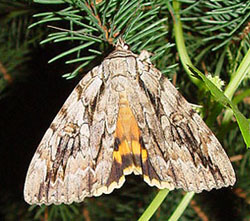
| ** 8797 Catocala subnata; Youthful Underwing: 75-90mm. Fws greyish white with blue-grey and light brown scales, usually with hws brighter yellow than those of neogama. Neogama usually have basal dash; absent in male subnata, but present in females. Magnification of hind tibia needed for id: subnata: cylindrical hind tibia; neogama: compressed or flattened hind tibia. subnata: ventral surface of tibia densely covered with evenly distributed spines; neogama: ventral surface of tibia sparsely covered. |
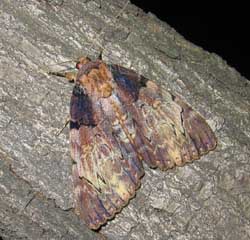
| ** 8796 TONHS Catocala nebulosa; Clouded; 75-86mm. Moths have prominent dark brown upper-half-basal patch that extends to and ends at antemedial line. Apical area also tends to be brown, much darker than median area but not as dark as basal patch. The anal angle also has the darker brown scaling. The pm line is distinct near costa and inner margin, but becomes weak between the two. It meets inner margin in relative close proximity to am line. Closed subreniform spot is large and connects to the pm line via a thin line. |
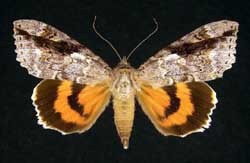
| ** 8804 TONHSCatocala marmorata; Marbled Underwing; 85-95mm; dark fw arc running from costa down through reniform spot to outer margin just below apex distinguishes this large species from all other "orange-pinkish-red" underwings. Subrenifrom spot light, bordered inwardly above by white patch, connected to pm line by a line rather than being open. endangered ?? |
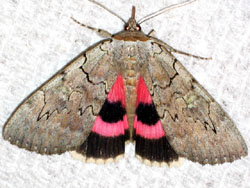
| ** 8833 TONHS concumbens Sleepy Underwing, Pink Underwing; 60-75mm. Brown thoracic collar quite evident in this image as is interruption in pm line by open subreniform spot.White hw fringe only lightly checked on wing veins. Vibrant pink bans distinct in colour, also in relatively smooth contour. |
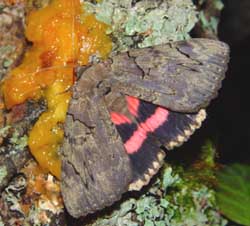
| ** 8832 TONHS Catocala cara; Darling; 70-85mm. Fw deep maroon almost purple cast, mixed with very pale green. Lower half of am & pm lines barely visible. No distinctive bars or dashes. Two upper "teeth" on the pm line: thin, long. Hw bands: pink. Heavy black checking on off-white hw fringe. Relatively thick black hw median band almost reaches im, usually heavily adorned with dark hairs. |
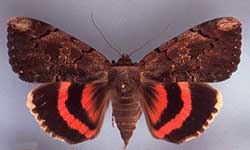
| ** Catocala carissima; 70-85mm. Distinct light grey brown area at fw apex, preceded inside pm line by slightly darker patch. Am, pm lines sharp, dark. Hw inner black band wide, complete, merges with extensive grey-black scaling along im. Hw fringe: cream. |
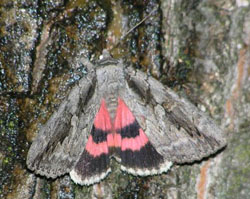
|
** 8834 amatrix Sweetheart Underwing; 75-95mm: Very skittish, frequently hides in caves, under bridges, under tree bark, etc. by day, resting with head down. Hw patterning, colouration similar to that of C. concumbens, but large size (75-95mm) and dark bar running from basal area to just below apex distinguishes C. amatrix. |
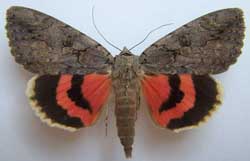
|
** 8834 amatrix form selecta Sweetheart Underwing; 75-95mm: Very skittish, frequently hides in caves, under bridges, under tree bark, etc. by day, resting with head down. Several forms, including selecta (left) lacking dark bar on fw. Hesseli: melanic form; pallida: very pale form. |
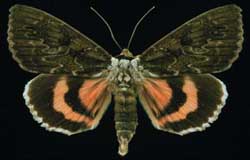
|
** 8834 amatrix form hesseli Sweetheart Underwing; 75-95mm: Very skittish, frequently hides in caves, under bridges, under tree bark, etc. by day, resting with head down. Melanic form hesseli: very dark, displays dark basal hairs in hindwing. |
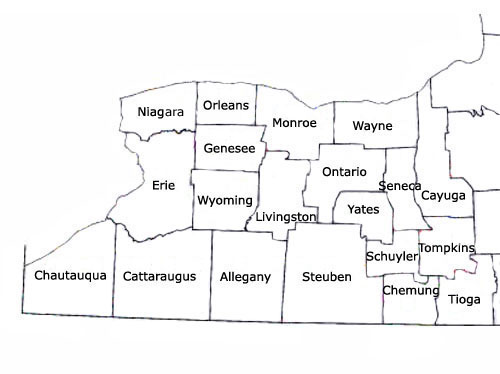
mid to late July: grynea (been regular for several weeks now), as well as subnata (2) and cerogama, Monroe County, Steve Daniel.
This page is very much in its infancy, but, by late
fall of 2006, I hope to have a pictoral thumbnail checklist completed
with active links to individual species files. It will probably be a long time
before the county checklists are active.
Individual notes for western counties:
Niagara |
Orleans |
Genesee |
Erie |
Wyoming |
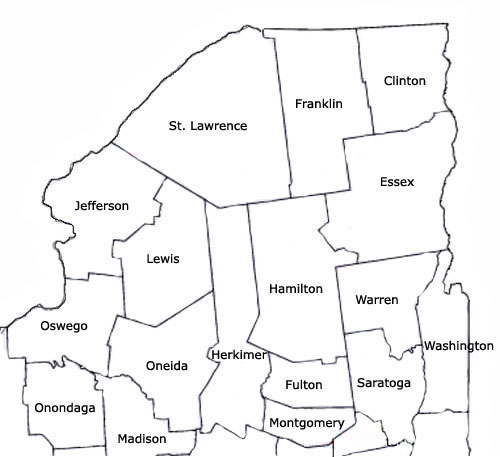
Oswego |
Lewis |
Oneida |
Onondaga |
Madison |
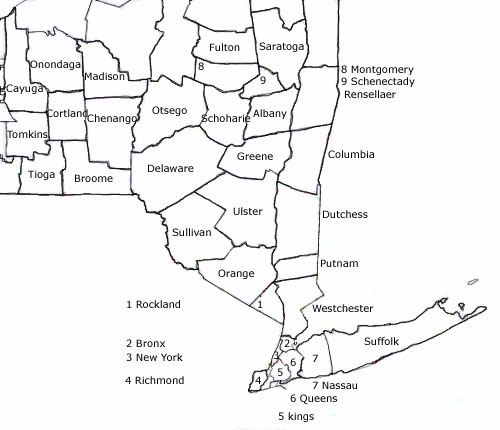
Based on good records from Connecticut and from South Carolina, I have interpolated the following species for New York.
Catocala epione
Catocala muliercula *p
Catocala antinympha
Catocala flebilis
Catocala obscura
Catocala retecta p
Catocala vidua *p
Catocala palaeogama *p
Catocala nebulosa *p
Catocala ilia *p
Catocala umbrosa p
Catocala relicta
Catocala cara
Catocala sordida p
Catocala gracilis *p
Catocala andromedae p
Catocala coccinata p
Catocala ultronia *p
Catocala crataegi *p
Catocala grynea p
Catocala praeclara p
Catocala similis *p
Catocala micronympha *p
Catocala amica *p
Catocala lineella *p
Hugh McGuinness
The Ross School
18 Goodfriend Drive
East Hampton, NY 11963
Marie Winn has sent the following list for Central Park, Manhattan,
New York County:
1. Girlfriend Underwing Catocala amica
On September 27, 2011 Hugh writes, "I don't consider September a good Catocala month, but this year I have
gotten three "lifers" this month. Perhaps I underestimate September because
most of the Catocala I don't find on eastern LI occur on western LI and the
mainland during July and early August. This month I found White Underwing
(Catocala relicta) at Teddy Roosevelt Co Pk in Montauk during the first
week of September. On September 22nd I found The Penitent (Catocala piatrix)
at Teddy Roosevelt. This morning I awoke to find Sad Underwing (Catocala
maestosa) at my light at home. This species apparently reaches its northern
limit on Long Island, and Marie Winn has seen them regularly in Central
Park. I have actually seen both relicta and piatrix before, but that was
during the 1980s. I had not seen either species since I started working
seriously with moths in 2002, and I consider anything I haven't seen since
then a lifer. Mothing has seemed slow otherwise with many common species
making only sporadic appearances at my house."
Connecticut Catocala; with Hugh McGuinness sigtings
for New York
innubens rare
2. Little-lined Underwing Catocala lineela
3. Ultronia Underwing Catocala ultronia
4. Little Underwing Catocala minuta
5. Widow Underwing Catocala vidua
6. Sad Underwing Catocala maestosa
7. Yellow-gray Underwing Catocala recta
8. Tearful Underwing Catocala lacrymosa
9. White Underwing Catocala relicta
10. The Betrothed Catocala innubens
11. The Little Wife Catocala muliercula
12. Oldwife Underwing Catacola Palaeogama
13. Habilis Underwing Catocala habilis
14. Yellow-banded Underwing Catocala cerogamma
15. The Bride Catocala neogama
16. Clouded Underwing Catocala nebulosa
17. Youthful Underwing Catocala subnata
18. Ilia Underwing Catocala ilia
19. Once-married Underwing Catocala unijuga
20. The Penitent Catocala piatrix
21. The Sweetheart Catocala amatrix
22. Darling Underwing Catocala cara
piatrix very rare
epione HM
antinympha HM
badia
habilis
serena
judith
flebilis HM
obscura HM
residua
retecta HM
dejecta
vidua very rare HM
palaeogama very common HM
subnata
neogama
ilia HM
cerogama very rare
relicta
unijuga
parta
briseis very rare
cara HM
concumbens
amatrix rare
sordida HM
gracilis HM
andromedae HM
coccinata HM
ultronia HM
crataegi HM
mira
blandula
grynea HM
praecara HM
similis HM
micronympha HM
amica HM
Hannibal, NY (Oswego County):
Catocala subnata 29-Jul-1998
Catocala cara 28-Aug-1996
Catocala ilia 11-Sept-1996
Catocala ilia f. conspicua (no date, prob. 1995)
Catocala neogama 29-Jul-1998
Catocala parta 28-Jul-1998
Catocala unijuga 28-Jul-1998
Catocala concumbens 11-Sept-1998
Catocala piatrix 06-Sept-1998
Catocala cerogama 28-Jul-1998
Catocala cerogama f. ruperti 19-Jul-1998
Catocala palaeogama 28-Jul-1998
Catocala ultronia 15-Aug-1997
Catocala grynea 15-Aug-1997
Catocala sordida 15-Aug-1997
Catocala relicta 27-Aug-1998
Catocala amatrix 20-Aug-2001
Wayne County: Town of Huron (nr. North Rose, NY)
Catocala ultronia, August 4, 2012
Catocala amatrix 01-Sept-2008
Catocala cara 15-Sept-2008
Wayne County: Village of Wolcott
Catocala relicta 28-Sept-2008
Use your browser "Back" button to return to the previous page.

|
butterfly to the left, a link to many worldwide insect sites. |